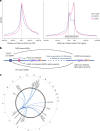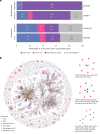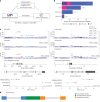The contribution of genetic determinants of blood gene expression and splicing to molecular phenotypes and health outcomes
- PMID: 40038547
- PMCID: PMC11906350
- DOI: 10.1038/s41588-025-02096-3
The contribution of genetic determinants of blood gene expression and splicing to molecular phenotypes and health outcomes
Abstract
The biological mechanisms through which most nonprotein-coding genetic variants affect disease risk are unknown. To investigate gene-regulatory mechanisms, we mapped blood gene expression and splicing quantitative trait loci (QTLs) through bulk RNA sequencing in 4,732 participants and integrated protein, metabolite and lipid data from the same individuals. We identified cis-QTLs for the expression of 17,233 genes and 29,514 splicing events (in 6,853 genes). Colocalization analyses revealed 3,430 proteomic and metabolomic traits with a shared association signal with either gene expression or splicing. We quantified the relative contribution of the genetic effects at loci with shared etiology, observing 222 molecular phenotypes significantly mediated by gene expression or splicing. We uncovered gene-regulatory mechanisms at disease loci with therapeutic implications, such as WARS1 in hypertension, IL7R in dermatitis and IFNAR2 in COVID-19. Our study provides an open-access resource on the shared genetic etiology across transcriptional phenotypes, molecular traits and health outcomes in humans ( https://IntervalRNA.org.uk ).
© 2025. The Author(s).
Conflict of interest statement
Competing interests: M.A.Q. is on the Key Opinion Leader panel for New England Biolabs. B.B.S. and H.R. are employees and stockholders of Biogen. C.D.W. is an employee and stockholder of Johnson & Johnson. S.P. and D.S.P. are employees and stockholders of AstraZeneca. D.J.G. is an employee and stockholder of BioMarin Pharmaceutical. D.J.R. is an employee of NHSBT. J.E.P. has received hospitality and travel expenses to speak at Olink-sponsored academic meetings (none within the past 5 years). A.S.B. has received grants outside of this work from AstraZeneca, Bayer, Biogen, BioMarin and Sanofi. M.I. is a trustee of the Public Health Genomics Foundation, a member of the Scientific Advisory Board of Open Targets and has a research collaboration with AstraZeneca that is unrelated to this study. The other authors declare no competing interests.
Figures





References
-
- Albert, F. W. & Kruglyak, L. The role of regulatory variation in complex traits and disease. Nat. Rev. Genet.16, 197–212 (2015). - PubMed
-
- Neumeyer, S., Hemani, G. & Zeggini, E. Strengthening causal inference for complex disease using molecular quantitative trait loci. Trends Mol. Med.26, 232–241 (2020). - PubMed
MeSH terms
LinkOut - more resources
Full Text Sources

